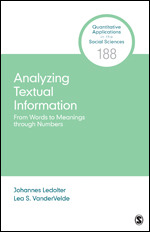Series Editor’s Introduction
Preface
Acknowledgments
About the Authors
Chapter 1: Introduction
1.2 The Two Applications Considered in This Book
1.3 Introductory Example and Its Analysis Using the R Statistical Software
1.4 The Introductory Example Revisited, Illustrating Concordance and Collocation Using Alternative Software
Chapter 2: A Description of the Studied Text Corpora and A Discussion of Our Modeling Strategy
2.1 Introduction to the Corpora: Selecting the Texts
2.2 Debates of the 39th U.S. Congress, as recorded in the Congressional Globe
2.3 The Territorial Papers of the United States
2.4 Analyzing Text Data: Bottom-Up or Top-Down Analysis
Appendix to Chapter 2: The Complete Congressional Record
Chapter 3: Preparing Text for Analysis: Text Cleaning and Formatting
Chapter 4: Word Distributions: Document-Term Matrices of Word Frequencies and the “Bag of Words” Representation
4.1 Document-Term Matrices of Frequencies
4.2 Displaying Word Frequencies
4.3 Co-Occurrence of Terms in the Same Document
4.4 The Zipf Law: An Interesting Fact About the Distribution of Word Frequencies
Chapter 5: Metavariables and Text Analysis Stratified on Metavariables
5.1 The Significance of Stratification and the Importance of Metavariables
5.2 Analysis of the Territorial Papers
5.3 Analysis of Speeches From the 39th Congress
Chapter 6: Sentiment Analysis
6.1 Lexicons of Sentiment-Charged Words
6.2 Applying Sentiment Analysis to the Letters of the Territorial Papers
6.3 Using Other Sentiment Dictionaries and the R Software tidytext for Sentiment Analysis
6.4 Concluding Remarks: An Alternative Approach for Sentiment Analysis
Chapter 7: Clustering of Documents
7.2 Measures for the Closeness and the Distance of Documents
7.3 Methods for Clustering Documents
7.4 Illustrating Clustering Methods on a Simulated Example
Chapter 8: Classification of Documents
8.2 Classification Procedures
8.3 Two Examples Using the Congressional Speech Database
8.4 Concluding Remarks on Authorship Attribution: Commenting on the Field of Stylometry
Chapter 9: Modeling Text Data: Topic Models
9.2 Fitting Topic Models to the Two Corpora Studied in This Book
Chapter 10: n-Grams and Other Ways of Analyzing Adjacent Words
10.2 Text Windows to Measure Word Associations Within a Neighborhood of Words and a Discussion of the R Package text2vec
10.3 Illustrating the Use of n-Grams: Speeches of the 39th Congress
Chapter 11: Concluding Remarks
Appendix: Listing of Website Resources



